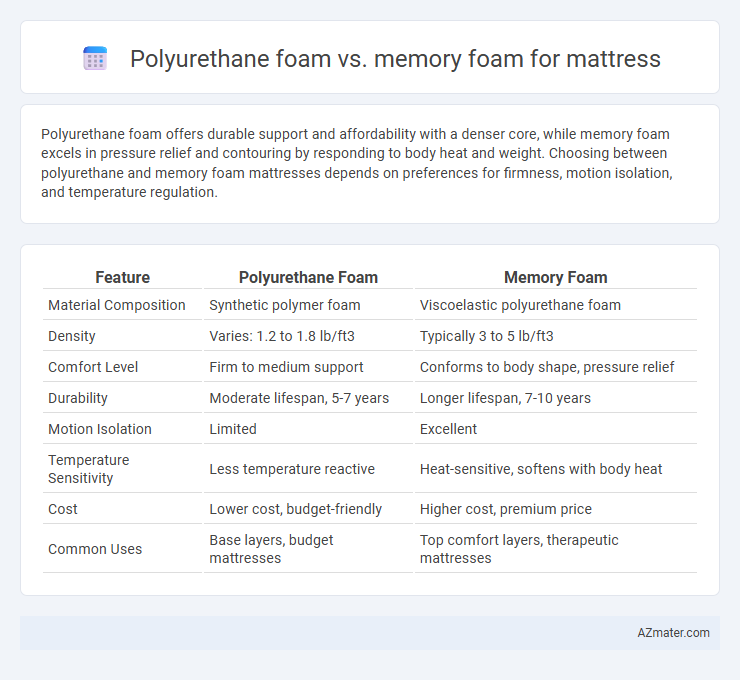Polyurethane foam offers durable support and affordability with a denser core, while memory foam excels in pressure relief and contouring by responding to body heat and weight. Choosing between polyurethane and memory foam mattresses depends on preferences for firmness, motion isolation, and temperature regulation.
Table of Comparison
| Feature | Polyurethane Foam | Memory Foam |
|---|---|---|
| Material Composition | Synthetic polymer foam | Viscoelastic polyurethane foam |
| Density | Varies: 1.2 to 1.8 lb/ft3 | Typically 3 to 5 lb/ft3 |
| Comfort Level | Firm to medium support | Conforms to body shape, pressure relief |
| Durability | Moderate lifespan, 5-7 years | Longer lifespan, 7-10 years |
| Motion Isolation | Limited | Excellent |
| Temperature Sensitivity | Less temperature reactive | Heat-sensitive, softens with body heat |
| Cost | Lower cost, budget-friendly | Higher cost, premium price |
| Common Uses | Base layers, budget mattresses | Top comfort layers, therapeutic mattresses |
Introduction to Polyurethane and Memory Foam
Polyurethane foam is a versatile, synthetic material known for its durability and affordability in mattress construction. Memory foam, a type of polyurethane foam infused with viscoelastic properties, offers superior pressure relief and body contouring by responding to heat and weight. Both foams vary significantly in density, firmness, and support, impacting overall mattress comfort and performance.
Composition and Material Differences
Polyurethane foam consists of synthetic polymers derived from petrochemicals, characterized by open-cell structures that provide varied firmness levels and durability. Memory foam, a type of viscoelastic polyurethane, incorporates temperature-sensitive materials like gel or plant-based additives that enable it to conform closely to body contours by reacting to heat and pressure. The distinct molecular composition of memory foam results in slower response time and enhanced pressure relief compared to the more resilient and buoyant polyurethane foam.
Comfort and Support Comparison
Polyurethane foam offers firmer support with higher density variations, making it ideal for individuals who prefer a more structured mattress feel, while memory foam conforms closely to body contours, providing superior pressure relief and personalized comfort. Memory foam excels in minimizing motion transfer due to its viscoelastic properties, which enhances sleep quality for couples, whereas polyurethane foam generally provides quicker response and better breathability. Both foams provide adequate support, but memory foam's ability to distribute weight evenly reduces pressure points more effectively compared to polyurethane foam.
Durability and Longevity
Polyurethane foam mattresses generally offer good durability but tend to degrade faster than memory foam, often lasting around 5 to 7 years. Memory foam mattresses provide superior longevity, typically maintaining comfort and support for 7 to 10 years due to their dense cellular structure. High-density memory foam resists sagging and retains its shape longer, making it a more durable option for long-term use.
Temperature Regulation and Breathability
Polyurethane foam mattresses often offer better temperature regulation and breathability than traditional memory foam due to their open-cell structure, which allows for greater air circulation and heat dissipation. Memory foam tends to retain body heat because of its dense construction, which can lead to a warmer sleep environment, although some advanced memory foams incorporate cooling gels or phase-change materials to enhance airflow and temperature control. Choosing between polyurethane foam and memory foam depends on individual preferences for thermal comfort, with polyurethane foam generally favored for those who prioritize cooler sleeping conditions.
Motion Isolation and Noise
Memory foam mattresses excel in motion isolation by absorbing and reducing movement transfer, making them ideal for couples or restless sleepers. Polyurethane foam mattresses often produce more noise due to their denser, less flexible structure, which can affect sleep quality. Memory foam's viscoelastic properties minimize noise generation, providing a quieter sleeping environment compared to traditional polyurethane foam.
Allergen Resistance and Hypoallergenic Properties
Polyurethane foam mattresses typically offer moderate allergen resistance but may contain chemical residues that can trigger sensitivities in some users. Memory foam, known for its dense structure and closed-cell composition, naturally resists dust mites and allergens, making it a preferred hypoallergenic choice for allergy sufferers. Both foams benefit from antimicrobial treatments, yet memory foam consistently excels in minimizing allergen accumulation and promoting a healthier sleep environment.
Price Comparison: Polyurethane vs Memory Foam
Polyurethane foam mattresses typically offer a more budget-friendly option, with prices often ranging from $100 to $500, making them accessible for most consumers. Memory foam mattresses tend to be more expensive, generally priced between $500 and $2,000, due to their advanced viscoelastic properties that provide enhanced comfort and pressure relief. The price difference is influenced by material density, durability, and manufacturing processes, with memory foam's superior contouring capabilities justifying the higher cost in many cases.
Best Use Cases for Each Foam Type
Polyurethane foam offers excellent support and durability, making it ideal for budget-friendly mattresses and those needing firmer sleep surfaces, which helps with alignment and pressure relief. Memory foam excels in contouring to body shape, providing superior motion isolation and comfort, making it best for individuals with chronic pain or those who share a bed and require minimal disturbance. Choosing between polyurethane and memory foam depends on preferences for firmness, body support, and temperature regulation during sleep.
Conclusion: Choosing the Right Foam for Your Mattress
Polyurethane foam offers firm support and durability at a budget-friendly price, ideal for sleepers who prefer a resilient surface. Memory foam contours closely to the body, providing superior pressure relief and motion isolation, making it suitable for those with joint pain or restless sleep. Selecting the right foam depends on individual comfort preferences, sleep position, and specific support needs to ensure optimal mattress performance.

Infographic: Polyurethane foam vs Memory foam for Mattress
 azmater.com
azmater.com